Laptop Mag Verdict
Parents in need of a kid-friendly tablet will appreciate the Kurio 7's parental controls and screen-time limits, but the display and battery life left us wanting more.
Pros
- +
Parents can set screen time
- +
Effective Web surfing parental controls
- +
Curated and family-safe app store
- +
Slick design for a children's tablet
Cons
- -
Mediocre display quality
- -
Sluggish performance
- -
Short battery life
Why you can trust Laptop Mag
If Junior has outgrown the Leapster but you're not ready to let him loose on your iPad, the $149 Kurio from Techno Source seems like a smart choice. This 7-inch Android 4.0 tablet includes a child-friendly interface that offers parents tons of extra controls that can be customized for up to eight users of different ages. Plus, this slate comes with lots of apps and games your little ones beg you to play on your device, such as "Angry Birds," "Where's my Water" and "Fruit Ninja." However, all this family fun comes with some trade-offs.
Design
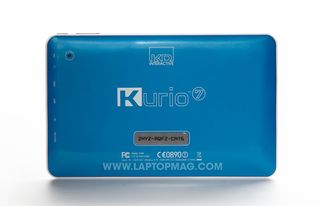
Click to EnlargeMeasuring 7.7 x 4.9 x 0.5 inches, the Kurio 7 is very similarly sized to the Nexus 7 (7.8 x 4.7 x 0.4 inches) and the Kindle Fire (7.5 x 4.7 x 0.5 inches). Weighing in at 12.5 ounces, it's a tad heavier than the 12-ounce Nexus 7, but lighter than the 14.1 ounce Fire. From the front, the Kurio 7 could pass for almost any 7-inch Android tablet.
The home, back and menu buttons almost disappear into the black bezel at the bottom, as does the 0.3-MP camera oddly placed in the upper right corner. The white plastic rim hugs the rectangular slate. This pop of color houses the power and volume rocker buttons on the sides. On the bottom edge you'll find multiple ports, including the miniUSB, miniHDMI, headphone and mic, miniSD Card slot and DC power port.
Unfortunately, the blue bubbled-out backside looks and feels like cheap plastic. The large, bright white logos mar the surface, as does the silver serial number sticker that we couldn't help picking at. We suppose, for the younger set, the clearly printed names for all the ports along the bottom edge could be helpful. The 2.1-MP camera on the bottom right is clearly designated by a ring of white.
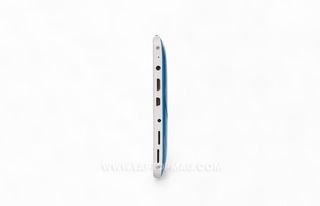
Click to EnlargeFor using all those ports, the Kurio comes with a DC wall plug, a miniUSB to USB cord and a miniUSB to HDMI converter cord. Also in the box is the blue Kurio Skin bumper. This thick, rubbery skin with a patterned rectangle on the back protects the device from dust and the small shocks and drops kids will surely cause. The case maintains access to all ports, except the miniSD slot. When the Kurio 7 wears its 7.5-ounce Skin it definitely takes on a more kiddie tablet air. Beginning in November, the bumper will be available in green or pink for $24.99. Plus, the company will offer licensed options branded with "Angry Birds" (red) and "Fruit Ninja" (green) for $29.99.
Display and Audio
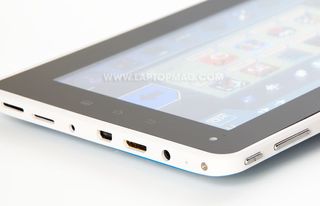
Click to EnlargeThe 7-inch, 800 x 480 Kurio 7 screen doesn't exactly wow, particularly compared with the 1280 x 800 display on the Nexus 7. Colors seemed muddy and whites looked almost blue with the brightness turned all the way up. On our brightness test we measured just 147 lux, which is sad compared with the 356 lux tablet average. The glossy screen also proved to be a fingerprint magnet. A YouTube trailer for "The Hobbit: An Unexpected Journey" looked flat and dark, and the glare from the screen made it difficult to find a good viewing angle.
Oddly, the single speaker for the Kurio sits along the bottom left rim. In landscape mode, we often found our hand muffling the tinny and anemic sound. "Santa Monica" by Everclear sounded distant and lacking depth. The strings of Mozart's "String Quintet No. 3" were clear, but could have been coming out of an old FM radio, if we didn't know better. If you want to listen to music or watch a movie, we recommend using the headphone jack.
Ice Cream Sandwich Interface
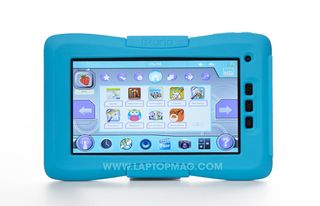
Click to EnlargeInstead of the slide lock often found on Android tablets, the Kurio 7 presents two finger-size holes to press to unlock the device. Once in, this slate neatly hides a dual-personality; Android 4 Ice Cream Sandwich for mom and dad, and Kurio for the little ones. From the Android side, you're greeted with five customizable home screens, and the back, home and recent apps icons along the bottom. The Notifications Box sits along the bottom right, where you can quickly scan the time, wireless connection and battery life.
Along the top left is a Google search bar for digging through the Web or the device, while the top right corner has a button to show all apps. This version of Android has already been outdated by Google's Jelly Bean, but the layout and interface was clean and easy to navigate.
The same stock keyboard we've seen on other Ice Cream Sandwich slates appears on the Kurio 7, even in the secondary Kurio UI. The plain gray keys offered an accurate typing experience. Typing produced haptic feedback that seemed to shake the whole tablet, and default sounds of every key press reminded us of an noisy old-school typewriter. Luckily; you can turn this effect off in settings.
Kurio UI
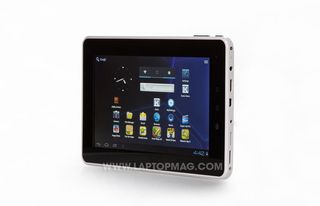
Click to EnlargeThe self-titled Kurio user interface gets to the heart of why Techno Source calls the Kurio 7 "the ultimate Android tablet for families." During setup you're asked to create a Parent account first, for which you'll need an email address, birth date, password and hint question. The tablet will also ask you to select a profile picture, which you can take using the device's camera or select from a few icons such as a strawberry or a purple cartoon character. The same process is followed for each of the eight profiles you can create.
Each profile can be protected by a password, using either text or a dot pattern. Once that's done you must set the Internet security level and all other parental controls (see more on that later). Once set up, the Kurio interface is what loads upon startup by default. This interface is specifically designed to be used in landscape mode.
Within each profile users are presented with a home screen that shows your profile picture and buttons in each corner. In the top left sits a lock icon that offers parents access to the master settings. You can switch user profiles from the top right. And on the left and right bottom are Wi-Fi settings and help buttons. When you touch your profile pic you're taken inside a desktop that's tailored to that person.
Each of the seven home screens for a given profile show up to 10 approved apps. Random icons sit above the apps differentiating the home screens, including a star, a happy face and a sideways lightening strike. Above the profile picture sit tiny icons indicating current Wi-Fi strength, time, volume controls and a battery meter.
Along the bottom are often-used icons for Wi-Fi settings, clock, Web browsing, music, video, camera, calculator and help. You can customize the apps you place here by tapping and holding. The browser icon opens a Google-powered SafeSearch broswer. The music and video icons open their respective libraries, while the camera icon activates the front or back cameras.
Parental Controls
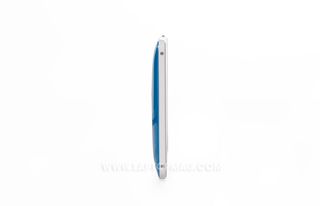
Click to EnlargeOnce you get to the Parental Area via the lock icon in the top left of the screen, you can download apps and content, change device settings and re-enter the Android interface. Here you're offered a wide variety of controls, including time management, Internet access with an approved list of sites, kid-safe filtering settings and approved applications.
We appreciated the time management features, offering parents the ability to limit the amount of time spent using the device during a single session, the amount of time between sessions and number of sessions per day. Plus, you can set the start and end time for usage during any given day. When we exceeded our play time, the Kurio 7 locked us out using a friendly note that told us we reached our time limit for that session and that we should try again later.
Within Internet Access mode, parents are offered an almost overwhelming number of choices. You can check off No Internet Access, or you can approve a list of sites or filter rules for Web surfing. And, for the adults in the family, there is a Full Internet Access mode. If you check off "Set Up Kid-Safe Web Content Filters," you'll need to go back a screen and enter the Content Filtering Parameters screen. Here you can set parameters by age (<7, 8-9 years, 10-11 years, 12+ years Normal or 12+ years Strict) or set up custom filters.
Custom filters can be a list of specific sites or a type of content (messaging, social networking, business, sex education and pregnancy, celebrity news, online streaming, health, sports, religion, online shopping, search engines and miscellaneous). To make exceptions to these rules for a specific site -- say, you don't want them reading about atheism but your local church is OK -- you can enter those URLs into the Approved Website List Settings area.
For the most part, the Kurio 7 did a good job of keeping our kids away from specified content. When we blocked celebrity news and searched Katie Holmes in the browser, plenty of relevant gossip links appeared. But clicking on them returned this error message, "Ooops! This page has been blocked by Kurio. Filtering parameters can be changed in the parental area." While huffingtonpost.com did load, we couldn't get into the entertainment section of the site. However, even after we approved Seventeen.com, we couldn't access the teen magazine's site.
When we set the Kid-Safe Web Content Filters to <7, we performed a series of searches in the Google SafeSearch browser. Digging for Ashleymadison.com did not return that particular site, but it did return a series of sites about the adult cheating site, including ask.com/ashleymadison.com as No. 1. Clicking that took us to an Ask search, which did return the actual site as a link. But when we clicked to open the adults-only site, we got the familiar error message. We got the same message when we searched for "big boobs" and "naked girls." And it appeared again when we directly entered URLs for Craigslist, Cosmopolitan.com, YouPorn.com and Trojanvibrations.com.
Bundled Apps
The Android UI on the Kurio 7 comes preloaded with only a handful of apps, including Aldiko Premium e-Reader, email, calendar, calculator, browser, camera, music and Super-HD Player for video. In addition to the Kurio Store and the app icon to open the Kurio interface, the rest of the choices are family-friendly apps such as "Angry Birds," "Cut the Rope," "DoodleJump," "FruitNinja HD," "Where's My Water" and "World of Goo." Opening the all apps screen provides access to the 16 Kurio-specific games.
In the Kurio UI, your children will still have access to Aldiko, calendar and all the games. A series of five Mr. Nussbaum educational games come preloaded, including "Lunch Lady" and "War Pretzels." While the graphics used in these games are fairly crude, we had fun brushing up on our basic geography and math skills. Other apps included a couple of coloring apps, disturbingly separated by gender, and one gender-neutral option. Universally, we find coloring with our finger (or a stylus) less than satisfying, and much more difficult to stay in the line, than on paper. But, perhaps, those with smaller fingers won't mind.
The Toon Goggles app proved most entertaining, which includes a series of preloaded and original cartoons. The shows are separated by six channels, such as Action, Comedy and Educational. The titles such as "Chuck Chicken" and "Action Dad" were fun, but the visuals looked somewhat cheap. The 23-minute "Agents of Meh" episode of "Action Dad" was like watching a low-res version of a Cartoon Network show, except one we'd never heard of. However, we appreciated the entertainment value for kids who would enjoy their own HBO Go-like app.
Web Browsing
The default browser on the Kurio 7 is reminiscent of Chrome, complete with tabs we could drag to re-order. When we had a solid Internet connection, Web pages loaded slowly. Space.com took 16 seconds to load. The mobile version of ESPN took 7 seconds to load, while NYTimes.com and Laptopmag.com took 9 seconds.
Kurio Store
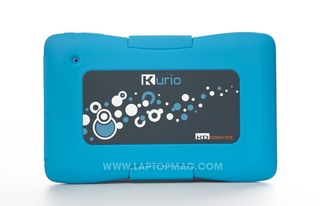
Click to EnlargeThe Kurio Store is a curated version of Google Play that currently contains about 1,000 apps. By comparison, the Toys 'R Us Tabeo children's tablet offers access to 6,000 apps. The home page of the Kurio store offers a specific list recommendations, as you'd expect (Bestsellers, New, Recommended, All and Free). You can also auto-sort apps by age range (Kid, Tweens, Teens and Adults). All of these sorting methods change the top row of featured apps that you can swipe through in a Coverflow-like fashion. Under Adult, we found only three apps. App prices ranged from free to around $25.
Among popular apps for mom and dad, we did find CNN, Facebook, Lookout Security and Antivirus, Quickoffice Pro HD, Pandora, Pulse, Twitter and YouTube available for download. We couldn't find Kindle, but we did find Barnes and Noble's Nook app for Android. Pandora downloaded and was up and playing in a few seconds. Within the Parental Area of Kurio UI, you can set which of your apps your child can access.
In addition, the Kurio 7 lets you sideload the apps, such as the Amazon App Store, by following directions on the KurioWorld.com site
Camera

Click to EnlargeThe Kurio 7's 0.3-megapixel front-facing camera made us look grainy, and its awkward placement in the top right corner made it difficult to use for taking self-portraits. The rear-facing camera produced somewhat better shots. Toys in a window took on a blue cast and colors appeared dull and lifeless. A video shot with the device of our newsroom was a bit choppy and dark. But we still think kids will enjoy shooting video and pictures, just like mom and dad.
Performance
With its single-core 1.2-GHz Cortex A8 CPU and 1GB of RAM, we expected the Kurio 7 to be a bit faster. We often found ourselves several clicks ahead of the tablet as we navigated around the Android user interface.
Synthetic benchmarks results mirrored our real-world experience. On Linpack, a test that measures CPU power, the Kurio 7 achieved a single-threaded score of 14.7 and a multi-threaded score of 14.2, much lower than the 38.6 and 59.2 tablet averages and laughingly behind the Nexus 7's 46.6 and 128.3 scores.
Similarly, on Quadrant, a benchmark that measures overall performance, the Kurio 7 scored 1,775, about 1,000 less than the 2,711.5 average and more than 1,500 less than the Nexus 7's 3,357 score.
On the graphics-oriented AN3DBench, the Kurio 7 scored a relatively strong 7,123, which actually beats the Kindle Fire's 7,006, but not the 7,293 tablet average.
Battery Life
The Kurio 7 is rated to last for 5 hours of video playback. However, on the LAPTOP Battery Test (Web surfing over Wi-Fi), the Kurio 7 lasted just 3 hours and 37 minutes. That's less than half of the 6:57 tablet average. By comparison, the original Kindle Fire lasted about 7.5 hours.
Verdict
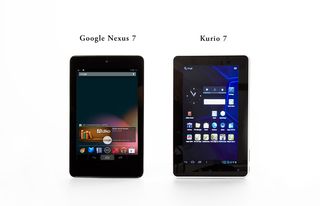
Click to EnlargeWhile it's not the fastest, brightest or longest-lasting Android tablet, the $149 Kurio 7 is worth a look for families. In a few clicks you can create multiple child profiles, restricting screen time and Web surfing while only allowing approved apps. Plus, this device comes with a handy case that is just right for small hands.
However, this slate faces some stiff competition from both the improved $159 Kindle Fire, which provides access to more content and has its own FreeTime kids mode. Meanwhile, the $149 Tabeo is coming in October from Toys 'R Us, and Archos also has its own Child Pad for $129. If you're looking for a safe and fun tablet for kids, the Kurio 7 is worth a look. Just don't leave the charger at home.
Techno Source Kurio 7 Specs
| CPU | 1.2-GHz Cortex A8 |
| Camera Resolution | 2.1 |
| Card Reader Size | 32GB |
| Company Website | http://www.kurioworld.com/us |
| Display Resolution | 800x480 |
| Front-Facing Camera Resolution | 0.3 |
| Graphics Chip | 350-MHz Mali-400 |
| OS | Android 4.0 |
| Ports | Mic, Headphone, mini-USB, Mini-HDMI |
| RAM Included | 1GB |
| Size | 7.7" x 4.9" x 0.5 |
| Storage Drive Size | 4GB |
| Storage Drive Type | Flash Memory |
| USB Ports | AddNewOpt |
| Weight | 12.5 ounces |
| Wi-Fi | 802.11b/g/n |
